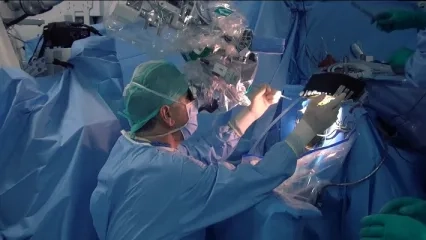Alo Yeditepe
Alo Yeditepe
Osteoporotic Spinal Fractures Can Cause Bigger Problems If Not Treated Early
Stating that osteoporotic fractures have a very important place in spinal fractures that can occur for many different reasons, Neurosurgery Specialist Prof. Dr. Ahmet Hilmi Kaya pointed out that if the healing potential in osteoporosis is weak, it can progress to progressive fracture. Prof. Kaya said that different treatment methods can be applied to spinal fractures according to the disease, the condition of the patient, and the fracture.
Spinal fractures, which cause serious problems regarding the quality of life of the person and closely concern his/her future life, can occur due to many different reasons.
Stating that the most common fractures are osteoporotic, that is, they occur due to osteoporosis and trauma, Neurosurgery specialist Prof. Dr. Ahmet Hilmi Kaya said, “However, certain pathological processes and tumor-related diseases that weaken the bone can also cause fractures of the spine.”
Reminding that the risk of osteoporosis and therefore the risk of fracture development in older women increases with menopause, Yeditepe University Koşuyolu Hospital Neurosurgery Specialist Prof. Dr. Ahmet Hilmi Kaya said that some conditions such as metabolic diseases, medication use, and sedentary life are among the factors in the occurrence of fractures.
“Beware of the Pain During Rest”
Stating that one of the most important findings of spinal fractures is pain, Prof. Dr. A. Hilmi Kaya gave the following information about pain, which patients often confuse with other problems:
“Osteoporotic fractures can cause severe pain at rest, even while sleeping. It is a blunt and severe pain that usually manifests itself acutely. The intensity of the pain, which concentrates on the spine, increases with movement. Sometimes it is not possible to distinguish this pain from different diseases or problems.”
Reminding that our spine contains very important structures such as the spinal cord and nerve structure, Prof. Dr. A. Hilmi Kaya said, “Therefore, if severe spinal fractures do not have the stability to support the spinal cord, deformity or even sudden paralysis may develop.”
The Important Thing is to Take Precautions Before the Fracture Occurs!
Underlining that osteoporosis should be followed up seriously in terms of fractures that may occur in the spine, Prof. Dr. A. Hilmi Kaya continued, “The important thing is to take precautions before a fracture occurs. For this, the bone structure should be strengthened with some medications and exercises. Other metabolic diseases that may be associated with osteoporosis should be controlled. In addition, some restrictive measures should be taken, especially in patients at risk of fracture.”
Different Treatment Methods Are Used According to the Condition of the Fracture
Stating that every bone can heal, Ahmet Hilmi Kaya said, “When a fracture occurs, if theoretically there is no spinal cord pressure, that is, we do not need a procedure to eliminate the secondary effect of the fracture, we first allow that bone to heal stably. The same approach is used for traumatic fractures. Unfortunately, this may not always be possible.”
Reminding that if the healing potential is weak in osteoporosis, it can progress to progressive fracture, Prof. Dr. A. Hilmi Kaya said, “In osteoporotic fractures, vertebroplasty, that is, the method of filling the bone, which we can apply more practically in the early stage after the fracture occurs, is extremely important. In this procedure, popularly known as bone cement, the substance we place into the bone solidifies the bone while it freezes. It also eliminates the feeling of pain. Therefore, it should not be forgotten that it may be a very necessary procedure to prevent bigger problems in the future.”
Conservative Methods Can Be Used in Non-Progressive Fractures
Stating, “if the fracture is not progressive and we trust the patient, we act conservatively”, Prof. Dr. Ahmet Hilmi Kaya continued his words as follows, “In this case, we can support the patient with a corset having a serious discipline without surgery. If there is a more progressive fracture and we cannot treat it by filling it, we may have to perform a very serious surgery in the future.”
The Spine is Supported by Screwing Technique
Stating that they can achieve very successful results with the screwing technique applied if there is no pathological condition in the bone in other normal fractures, Prof. Dr. A. Hilmi Kaya noted, “Beyond that, in some pathological fractures, we can support the entire spine with an artificial new spine, if necessary. We treat it by supporting the spine completely with different instrumentation techniques such as screws. In other words, we can have very different treatment methods depending on the disease, the structure of the patient, and the condition of the fracture. Our goal is to prevent the fracture from being damaged before more serious secondary problems occur.”
“In Case of Spinal Fractures, A Physician Should Be Consulted Without Losing Time”
Stating that some precautions should be taken to prevent these patients from experiencing a fracture, Yeditepe University Koşuyolu Hospital Neurosurgery specialist Prof. Dr. Ahmet Hilmi Kaya said, “For this, physical therapists, rheumatologists, and even endocrinologists help a lot today. When there is a problem, we step in. In order to determine the risk ratio of spinal fractures, a physician should be consulted as soon as possible. Because during treatment, we must find answers to questions like “Will the spine be affected, will the spinal cord in it be damaged, is the fracture stable?”
This content was prepared by Yeditepe University Hospitals Medical Editorial Board.
”
See Also
- Causes and Treatment Methods of Cervical Herniated Disc
- What is Parkinson's Surgery?
- Brain / Spinal Cord Spine and Nerve Surgery (Neurosurgery)
- Lumbar Spondylolisthesis (Lumbar Slipped Vertebrae)
- Lumbar Spinal Stenosis
- Spinal Fractures
- Narrow Cervical Canal and Myelopathy
- Brain Battery Connecting Parkinson Patients to Life
- Not All Hand Tremors Are Caused by the Parkinson's Disease
- When Does the Spine Require Surgical Treatment?
- Patient Selection is Important in Parkinson's Surgery
- Canal Narrowing in the Spinal Cord
- Beware If Your Walking Distance Is Decreasing!
Alo Yeditepe



